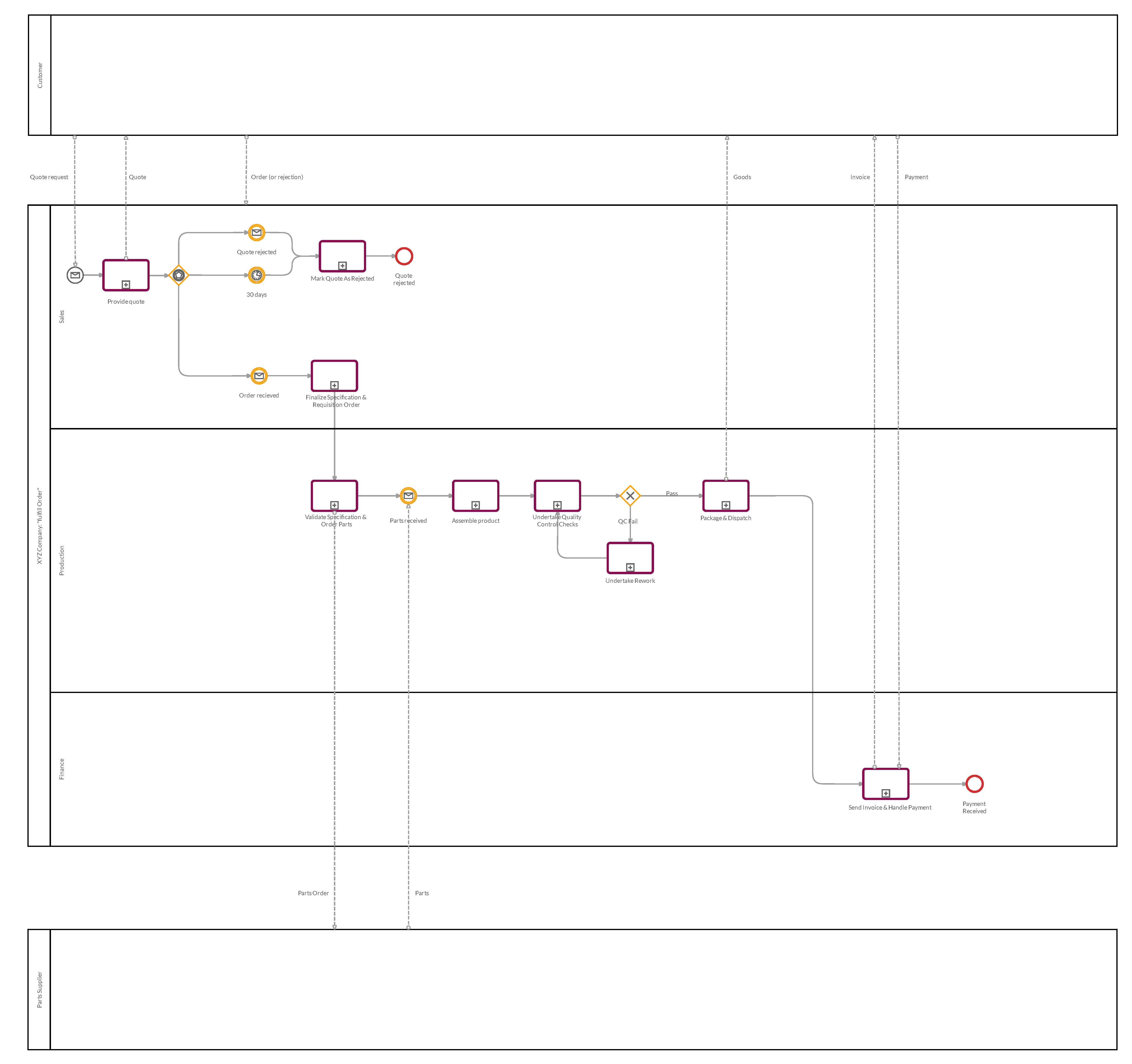Supply chain process management: how to model end-to-end processes with BPMN
Written by Alessandro Turco
23 May 2023 · 7 min read

For an organization to operate efficiently and effectively, it’s important that there is a clear understanding of how work is done. In an increasingly interconnected world, the delivery of products and services relies on collaboration with multiple external partners and suppliers. Ensuring that the right information and parts get to the right place at the right time is crucial and supply chain process management can be a key enabler for this.
It is worth starting with a definition of supply chain management. The following definition from Daniel Stanton is particularly useful:
“Supply chain management is the planning and coordination of all of the people, processes, and technology involved in creating value for a company. [...] In other words, it means looking at your business as a single link in a long, end-to-end chain that supplies something of value to a customer.” (Stanton, 2018)
This definition highlights the importance of understanding how a business delivers a product or service from end to end. Having this understanding of how the organization operates will allow for planning, optimization of workflow, monitoring, the implementation of service improvements and so on. In fact, if improvements are made without an end-to-end view of the process, there is a real danger that individual departments might seek to make localized changes that work for them, but actually make things worse elsewhere. This is why supply chain process management is so important.
All of this makes intuitive sense, but a question that is often asked is how can this end-to-end understanding be gained? Particularly when an end-to-end supply chain can be so broad, the challenge can seem insurmountable.
Gaining understanding by modeling a supply chain
A great way of beginning to create a shared understanding of a supply chain is to model it. This might start informally, with a supply chain process flow chart being created in a conference room with sticky notes on a wall (or, on a virtual whiteboard if the session is conducted remotely). This is a hugely valuable exercise, and is a great way to get different teams and stakeholders involved in modeling business processes. It usually uncovers just how long the end-to-end chain of activities is, and how many people are involved. In many cases, ideas for improvement will start to emerge immediately.
While these informal models are useful for eliciting and creating an initial understanding, when modeling supply chains there will be a point at which it’s appropriate to move to a more formal model. This is particularly true if the organization wants to improve and manage its processes. Sticky notes on a conference wall will help create an initial understanding, but a more sustainable and maintainable artifact is needed for the long term.
This is where a notation such as Business Process Model and Notation (BPMN 2.0 notation) is useful.

Using BPMN notation to drill down into the detail
There are a number of advantages of using BPMN notation when modeling business processes. BPMN 2.0 is a widely used standard and the OMG (Object Management Group) through the Modeling Interchange Working Group (MIWG) enforces interoperability among software providers. . The fact that it is widely used means that a good BPMN model can be used to precisely convey information across different organizations and stakeholder groups. It is possible to create a single model that different teams refer to, with each team seeing the parts that are relevant for them.
This is where some readers may, completely understandably, have some reservations. There is sometimes a view that BPMN is extremely complex and a stakeholder would need to be an expert to read it. However, the beauty of BPMN notation is that you can create a ‘view’ of a process that is as detailed or abstract as a particular stakeholder group needs, and it certainly isn’t usually necessary to include all the different symbols on a single diagram! In fact, if we are wanting a high-level view of a process, we might use placeholders (Call Activities) and draw details in a separate and dedicated view.
Modeling business processes: start with context
Let’s take two hypothetical diagrams as an example and examine a process which represents a particular part of a supply chain. We’ll examine two ‘views’ of the same process, each with a different amount of detail shown. The first shows ‘black box pools’. That is, each participant (pool) is shown but the detail isn’t. Put differently, the high-level data flows and conversations are shown, but the BPMN workflow is not shown:

A diagram like this is useful for showing the context and scope of a process. In fact, if you are wanting to model a complex end-to-end process it can be a good place to start. Understanding the participants (pools) that are involved, and the message flows between them can help to ensure that sufficient breadth of the process is considered. In fact, a good question to ask at this point is “how do we know that work needs to start” (what is the start event) and “at what point do we know the process is complete” (the end event). These events aren’t yet shown on the model, but in many cases there will be some kind of corresponding message for them (particularly for the start event).
These types of diagrams can also be useful in the initial stages when planning some kind of digital transformation. It might be, for example, that the organization wants to implement a self-service portal for its client. A diagram like this will start to hint at some of the functionality that such a portal would need (quotation, ordering, invoicing and so forth). Of course, the diagram is not extensive or complete, but it shows enough information to be useful in some contexts.
Modeling business processes: expanding the detail
It’s very likely that stakeholders will very soon want to see more detail. In the diagram below, you’ll see lanes are used to show how work flows throughout the organization. Crucially, Call Activities are shown. This denotes that more detail could be modeled… but it isn’t shown here. You will almost certainly see gaps and issues with this process, and tasks, message flows or subprocesses that you want to add. That illustrates the beauty of a model like this—it’s easy to understand, and gaps ‘jump out’ at stakeholders with the relevant knowledge. It also allows cross-checking of information: if there is a message flow shown that isn’t ‘consumed’ by the process then that’s a potential gap. Either something’s been missed, or the message needs to be dealt with by another process elsewhere (and moved to the relevant process). Either way, this will be a key thing to validate.

Of course, it would be possible to dive down into even more detail than is shown in this diagram. Each Call Activity could be modeled in a separate diagram, where there is plenty of space to show details. BPMN notation allows for as much detail to be captured as necessary. Equally, at the top level it is clear that this isn’t the only process in the end-to-end supply chain, so analysis could be expanded and other processes captured too.
For process management consider notation and tooling
This hierarchical approach to modeling a process can be extremely helpful when modeling a supply chain from end to end. It enables a ‘big picture view’ to be taken, as well as a more detailed view. Starting with a high-level model will ensure it’s easier to ask at which point we should start and stop modeling: answering the crucial question “when does the process actually start and end?”
Having a shared notation, such as BPMN 2.0, that key stakeholders understand will enable potential improvements to be discussed in the context of the end-to-end model. This will help avoid implementing localized ‘efficiencies’ that improve the local work but displace inefficiencies elsewhere.
When it comes to ensuring that the process models are maintainable, this question of notation is important. If they are going to be used and kept up-to-date, it’s key for stakeholders to understand and adopt the notation. Similarly, it’s important to choose a suitable BPMN editor that will allow process artifacts to be stored centrally, and accessed by the relevant stakeholders.
Conclusion
Organizations that want to manage or improve their supply chain will find it useful to model their end-to-end processes. Starting high-level, exploring the boundaries of the processes can be useful, before elaborating into further detail. While initial modeling might be informal and hand-drawn, there’s benefit in moving to more formal models, using a notation such as BPMN. Thinking about tooling, which BPMN editor to use, and where the artifacts will be stored is important. Ensuring that the tool is easy-to-use, and facilitates the storage of models in a shared, central location will prove beneficial.
Cardanit is among the software tested by MIWG and offers the features described above. You can sign up for free and practice with the described supply chain model which is now part of our templates together with examples from other industries like IT, finance and public administration.
Further reading
Optimizing warehouse management processes with BPMN
Quick guide to efficient business process mapping
BPMN in transportation: Optimizing a port rail system
Alessandro Turco has a PhD in Applied Math from the International School of Advanced Studies (SISSA) of Trieste and a Master in Management from the School of Management of Milan Polytechnic (MIP). He worked for ESTECO SpA for ten years, starting as a researcher for the Numerical Method Group and then moved to project manager of Cardanit.
Alessandro Turco has a PhD in Applied Math from the International School of Advanced Studies (SISSA) of Trieste and a Master in Management from the School of Management of Milan Polytechnic (MIP). He worked for ESTECO SpA for ten years, starting as a researcher for the Numerical Method Group and then moved to project manager of Cardanit.
Use it as a reference list of the most used elements in BPMN and DMN or as a guide on how to put those elements into practice.
Free BPMN and DMN cheat sheet
Use it as a reference list of the most used elements in BPMN and DMN or as a guide on how to put those elements into practice.
Free BPMN and DMN cheat sheet
Use it as a reference list of the most used elements in BPMN and DMN or as a guide on how to put those elements into practice.
